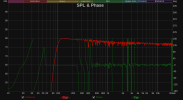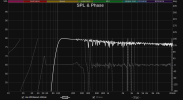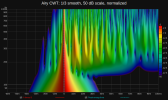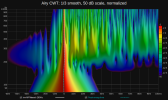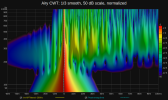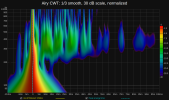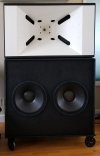Do you have in room measurements (bode plots) of your complete system?
Here's a transfer function of the same single speaker in #76, made at 1m out in the room.
This one has the 18"s in the syn horn reaching down to a little below 30Hz.
It does not include the dual 18" sub under the white horn.
This may sound a little incredible...but having made 10's of thousands of transfer and impulse measurements on DIY speakers over the last decade,
I've never bothered making full-system indoor listening-position measurements.
I've made many in-room measurements for just subs, and trying different sub deployments, but not for mains w/wo subs at LP.
All my main speaker measurements and tunings have been made as quasi-anechoic as possible, preferably outdoors, but sometimes indoors at 1m or so.
After the best quasi-anechoic tuning I can achieve, I live with the system indoors, and let my ears guide me in making acoustic treatments / positioning etc...and using general tone control EQs.
Large horns hold good directivity down low, and their constant directivity I keeps sound off sidewalls.
Everything sounds awesome...So I've never been overly concerned with room-correction.
Ok, all that said...I made my first full-range, main and sub listening position measurements, literally this last week.
Reason being, .bought Dirac Live RCS at the 30% off sale last month. Standalone on PC.
Finally trying some room correction...
Here's just the left side, but does include both main and sub.
Purple is before Dirac, blue after. Used Dirac's tight correction pattern, and let it do its thing 20Hz to 20kHz, just to see how it works for now.
The 18"s in the main are high-passed at 40Hz; the 18"s in the sub are low passed at 80Hz. I can see I have a phase issue between them at listening position.
Will fix that.
One cool aside is, I think I've worked out how to make transfer functions of what Dirac is doing
electrically.
It appears at quick look, that for a single speaker Dirac essentially performs straight minimum phase magnitude corrections. ( which of course also corrects phase)
When I ran it for 2 speaker stereo, the first speaker again appeared to get only min phase mag corrections, whereas the second speaker got both min phase mag corrections and additional phase only corrections.
Gonna dissect this ...always been a roll my own kinda dude !
 drive.google.com
drive.google.com


